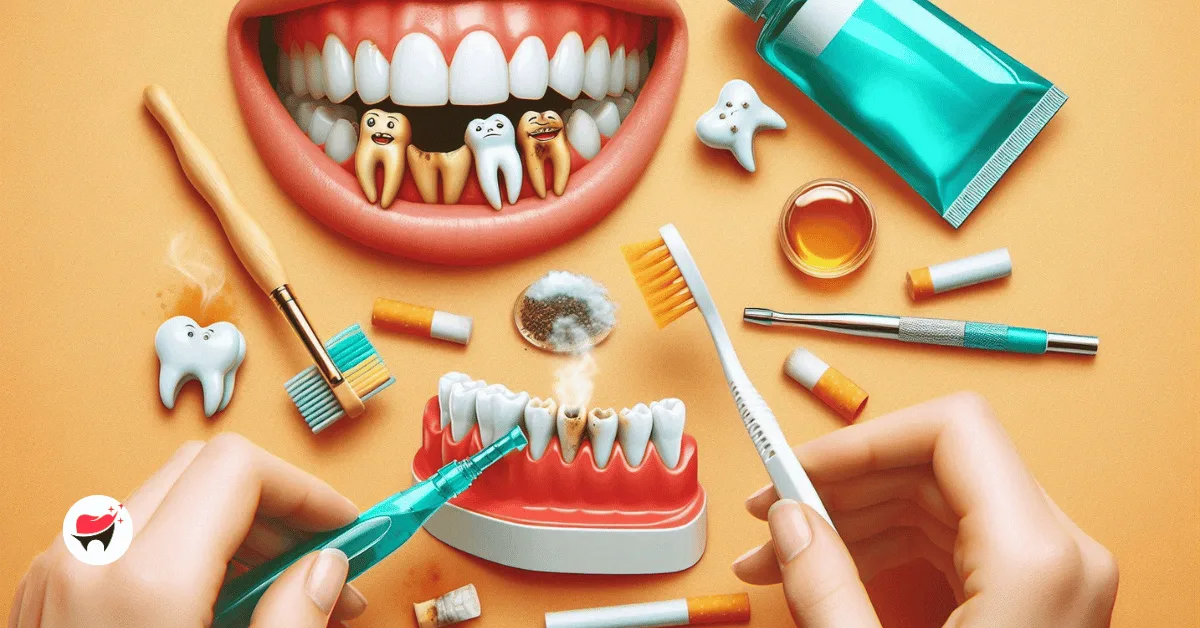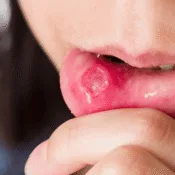
How to Effectively Remove Nicotine Stains from Teeth 🦷🚭
Nicotine stains, often resulting from smoking or using tobacco, can make your teeth appear yellow or even brown over time. These stubborn stains not only impact the aesthetics of your smile but can also contribute to long-term oral health problems. While the most effective solution is quitting smoking, there are multiple ways to help remove nicotine stains from teeth, both at home and with professional treatments.
In this comprehensive guide, we will dive into the causes of nicotine stains, explore the best methods to remove them, and offer tips to help prevent future staining.
✅ What Are Nicotine Stains? 🤔
Nicotine stains refer to the yellowish or brownish discoloration on the teeth caused by nicotine and tar found in tobacco products. While nicotine itself is colorless, when combined with oxygen in the mouth, it creates chemical reactions that stain teeth. The sticky nature of nicotine and tar causes these particles to attach firmly to the surface of the enamel, resulting in visible stains.
The stains can range from light yellow to dark brown, depending on how long you’ve been smoking and how often you expose your teeth to nicotine. As these stains are more stubborn than regular food stains, they may require extra effort to remove.
✅ Why Do Nicotine Stains Appear on Teeth? 🧐
Nicotine stains develop due to the following reasons:
1. Tobacco Particles and Tar 🍂
The primary contributor to nicotine stains is the tar in tobacco smoke. This sticky substance easily adheres to tooth enamel, causing discoloration over time.
2. Chemical Reactions in Saliva 💨
When nicotine enters the mouth, it reacts with the proteins and bacteria in the saliva, leading to the buildup of yellow or brown stains on the teeth.
3. Plaque Accumulation 🦷
Smoking increases plaque buildup, which is a sticky film of bacteria that forms on teeth. This plaque can harden into tartar, further exacerbating stains and making them harder to remove.
4. Weakened Enamel 🦷
Nicotine and tobacco can erode tooth enamel, making the underlying yellowish dentin more visible. Over time, this makes stains even more pronounced.
✅ How Can You Remove Nicotine Stains from Teeth? 🦷
Removing nicotine stains from your teeth can be challenging, but there are multiple methods available, ranging from simple home remedies to professional dental treatments. Here are some of the best ways to address nicotine stains:
1. Whitening Toothpaste 🪥
Using whitening toothpaste is one of the simplest ways to gradually reduce nicotine stains. These toothpastes contain abrasives that gently scrub off surface stains and ingredients like baking soda or hydrogen peroxide to break down deeper stains.
-
How to use: Brush your teeth with whitening toothpaste twice daily, focusing on the stained areas. Make sure to use a soft-bristled toothbrush to avoid damaging your enamel.
Effectiveness: Whitening toothpastes can be effective for mild to moderate nicotine stains. For deeper stains, you may need additional treatments.
2. Professional Teeth Cleaning 🦷
A professional teeth cleaning at the dentist’s office is one of the most efficient ways to remove nicotine stains. Dentists use specialized tools, including ultrasonic scalers, to clean your teeth and remove built-up tartar and plaque that may be contributing to the staining.
-
How it works: The dentist will perform a thorough cleaning, followed by polishing to smooth out the surface and reduce staining.
Effectiveness: Professional cleaning is highly effective for stubborn stains and also helps prevent future staining by maintaining oral hygiene.
3. Teeth Whitening Treatments 🦷
For more severe nicotine stains, teeth whitening treatments can provide faster and more significant results. These treatments use stronger bleaching agents, such as hydrogen peroxide, to break down the stains and restore the natural whiteness of your teeth.
-
At-home options: Over-the-counter whitening strips or trays that contain hydrogen peroxide can be applied daily.
-
Professional whitening: Dentists offer in-office treatments that use stronger bleaching agents for quicker results.
Effectiveness: Teeth whitening is one of the most effective ways to remove deep nicotine stains, with professional treatments providing faster and more noticeable results.
4. Oil Pulling with Coconut Oil 🛢️
Oil pulling is a traditional remedy that involves swishing oil (such as coconut oil) in your mouth for a few minutes to remove bacteria and plaque. This method is believed to help whiten teeth naturally.
-
How to use: Swish one tablespoon of coconut oil around in your mouth for 10–15 minutes. Spit it out and rinse your mouth with water.
Effectiveness: Oil pulling can help remove plaque and bacteria, gradually reducing nicotine stains. It may take longer to see results compared to other methods.
5. Baking Soda and Hydrogen Peroxide Paste 🍚
Baking soda combined with hydrogen peroxide is a natural and affordable way to remove surface stains from nicotine.
-
How to use: Mix a small amount of baking soda with hydrogen peroxide to form a paste. Apply it to your teeth with a toothbrush and gently scrub for 2-3 minutes.
Effectiveness: Baking soda’s abrasive texture helps scrub away surface stains, while hydrogen peroxide helps break down the discoloration deeper in the enamel.
6. Maintain Good Oral Hygiene 🦷
Regular brushing, flossing, and using mouthwash are essential to keep nicotine stains from accumulating and to maintain oral health. A good oral hygiene routine helps remove plaque and bacteria that contribute to staining.
-
How to use: Brush at least twice a day with fluoride toothpaste, floss daily, and use an antibacterial mouthwash.
Effectiveness: Regular oral hygiene not only helps prevent nicotine stains but also promotes healthier teeth and gums.
✅ How Can You Prevent Nicotine Stains in the Future? 🚫
While removing existing nicotine stains is possible, the key to keeping your smile bright is prevention. Here are some tips:
1. Quit Smoking 🚭
The best way to prevent nicotine stains is to stop smoking. Quitting smoking not only improves your oral health but also reduces your risk of gum disease and oral cancer.
2. Brush and Rinse After Smoking 🪥
If you find it difficult to quit smoking right away, make it a habit to brush your teeth or rinse with mouthwash immediately after smoking to minimize the accumulation of nicotine and tar on your teeth.
3. Drink Water After Smoking 💧
Drinking water after smoking helps rinse away some of the nicotine and tar before it can stick to your teeth. It also keeps your mouth hydrated and reduces the dry mouth that smoking often causes.
4. Use a Straw 🥤
If you smoke or consume other staining beverages like coffee or tea, using a straw can help limit contact between the liquid and your teeth.
✅ Statistics About Nicotine and Teeth Staining 📊
-
60% of smokers experience some form of tooth discoloration due to smoking.
-
Teeth whitening treatments can remove up to 90% of surface stains, including nicotine stains, depending on the severity.
-
On average, professional teeth whitening can provide noticeable results in just one visit, compared to a few weeks with at-home treatments.
-
Smokers who quit smoking can reduce their risk of further staining by 50% within the first 6 months.
✅ Frequently Asked Questions (FAQs) About Nicotine Stains ❓
-
Can nicotine stains be completely removed from teeth?
Yes, nicotine stains can usually be significantly reduced or completely removed with the right treatment. Professional whitening or teeth cleaning is highly effective for deep stains. -
How long does it take to remove nicotine stains?
It depends on the method used. Professional treatments can show results in one session, while at-home methods may take several weeks. -
Can nicotine stains come back after whitening?
Yes, if you continue smoking, nicotine stains can reappear. Quitting smoking is the best way to prevent further staining. -
Is it safe to whiten teeth at home?
Home whitening treatments, like whitening strips or trays, are safe when used according to instructions. However, it’s important not to overuse them to avoid damaging the enamel.
Conclusion: How to Remove Nicotine Stains from Teeth 🦷
Nicotine stains can be difficult to remove, but with the right approach, you can restore the brightness of your smile. From professional cleaning to at-home remedies like baking soda paste and oil pulling, there are various ways to effectively remove nicotine stains. While quitting smoking is the best long-term solution, using the right whitening treatments and maintaining proper oral hygiene can help prevent further discoloration.
With patience and consistency, you can get back to smiling with confidence, free from nicotine stains.
Recent Posts
How to Stop Bad Breath from Mouth: A Complete Guide
How to Effectively Remove Nicotine Stains from Teeth 🦷🚭
How to Treat Severe Mouth Ulcers? 😖🦷
All Categories
- Anesthesia
- Cosmetic Dentistry
- Health, Wellness and Ergonomics
- Hygiene
- Imaging, CBCT, and Radiography
- Implant Dentistry
- Laser Dentistry
- Marketing
- Oral Pathology, Pharmacology, and Cariology
- Oral Surgery
- Orthodontics
- Paradental and Infection Control
- Prosthodontics
- Public Health
- Research
- Restorative Dentistry
- TMJ and Occlusion




